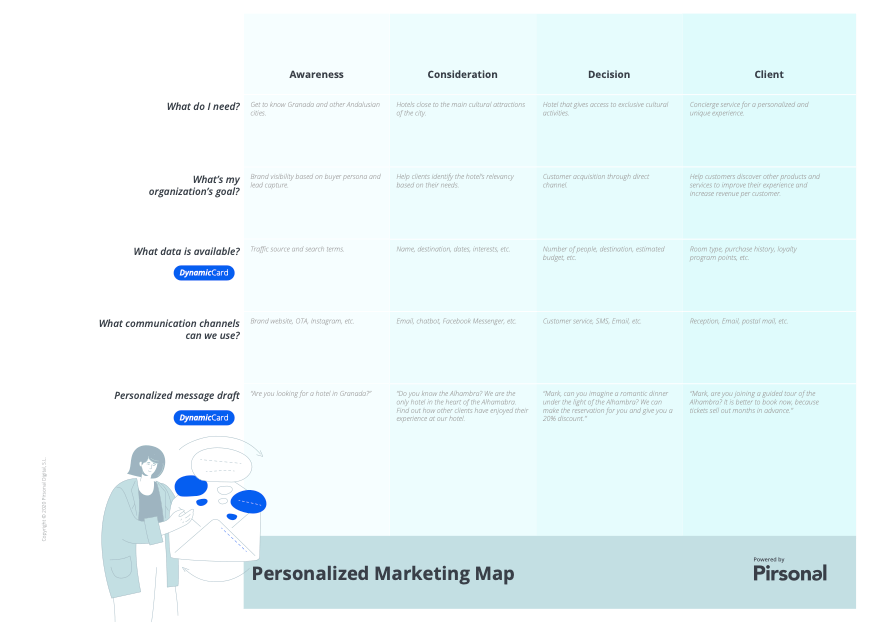In today’s competitive business landscape, having a well-defined and effective B2B marketing plan is crucial for success. B2B marketing focuses on targeting businesses rather than individual consumers, making it essential to develop strategies that resonate with your target audience.
To create a great B2B marketing plan, you must understand B2B marketing and your target audience. Set clear goals, create a strong value proposition, a smart marketing strategy, and engaging content. Use effective lead generation tactics and track results. Optimize the plan and adapt to changes as needed.
To be effective in B2B, you must remember that businesses are made up of people who make decisions.
These individuals need to make informed decisions.
So, in a crowded market, it is critical that your marketing adapts to the individual, using personalization to make your message more contextual and effective.
And also rely on automation to help you scale your efforts no matter the size of your marketing team or even the size of your audience.
Here’s a guide that will help you create a successful B2B marketing plan. It will show you how to focus on individual B2B buyers and their context to achieve your marketing goals.
Understanding The Basics Of B2B Marketing
B2B marketing refers to the strategies and tactics used by companies to promote their products or services to other businesses.
Unlike B2C marketing, where the focus is on reaching individual consumers, B2B marketing is targeted toward organizations and professionals.
It involves building strong relationships, delivering value, and addressing the specific needs of businesses.
B2B marketing plays a vital role in the growth and success of companies across various industries.
It helps businesses generate leads, acquire new business customers, and nurture long-term relationships.
By understanding the nuances of B2B marketing, businesses can position themselves effectively in the market and achieve sustainable growth.
Key Differences Between B2B and B2C Marketing
While B2B and B2C marketing share some similarities, there are significant differences that marketers need to consider.
As a marketer, it is critical to know these differences no matter the experience you have.
Understanding these distinctions is crucial for developing effective B2B marketing strategies.
Here are some key differences:
1. Target audience: In B2B marketing, the target audience is composed of businesses, professionals, and decision-makers. The marketing messages and tactics need to be tailored to address the specific pain points and requirements of these audiences. In contrast, B2C marketing targets individual consumers and focuses on appealing to their emotions and desires.
2. Decision-making process: B2B purchasing decisions often involve multiple stakeholders and a more complex decision-making process. These decisions are typically based on factors such as cost, ROI, functionality, and long-term benefits. B2C purchases, on the other hand, are often driven by personal preferences, emotions, and immediate needs.
3. Relationship-building: Building strong relationships is crucial in B2B marketing. As businesses engage in long-term partnerships, trust and credibility play a significant role in decision-making. B2B marketing efforts focus on nurturing relationships through personalized interactions, networking events, and providing ongoing support. In contrast, B2C marketing often emphasizes transactional relationships, where the primary goal is to drive immediate sales.
Benefits of B2B Marketing
B2B marketing offers several benefits that can positively impact a business’s growth and success. Let’s explore some of these benefits:
- Increased brand awareness and visibility: Effective B2B marketing strategies help businesses enhance their brand visibility and establish a strong market presence. By targeting the right audience and delivering relevant and valuable content, businesses can position themselves as industry leaders and increase brand recognition.
- Lead generation and customer acquisition: B2B marketing strategies are designed to generate high-quality leads and acquire new customers. Through targeted B2B campaigns, businesses can attract prospects who are more likely to convert into paying customers. This can result in a steady stream of revenue and business growth.
- Long-term customer relationships and loyalty: B2B marketing focuses on building long-term relationships with customers. By delivering exceptional value and consistently meeting customer needs, businesses can foster loyalty and secure repeat business. Repeat customers not only contribute to revenue but also act as brand advocates, referring new business to the company.
Understanding the B2B Buyer’s Journey
To effectively engage with B2B customers, businesses must understand the buyer’s journey—a process that potential customers go through before making a purchase decision.
The B2B buyer’s journey can be divided into three stages:
- Awareness stage: At this stage, businesses identify a problem or need and begin researching potential solutions. B2B marketers can provide educational content and resources to help prospects gain awareness and understanding of their offerings.
- Consideration stage: During this stage, prospects evaluate different options and compare vendors. B2B marketers should provide detailed product information, case studies, and testimonials to showcase the value and benefits of their offerings.
- Decision stage: In this final stage, prospects are ready to make a purchase decision. B2B marketers should provide clear pricing information, offer demos or trials, and address any remaining concerns or questions to facilitate the decision-making process.
By understanding and mapping the buyer’s journey, businesses can tailor their marketing efforts to effectively engage and nurture prospects throughout each stage.
Researching Your Target Audience
The first step in creating a successful B2B marketing plan is conducting thorough research on your target audience. This will lead you to accurate customer segmentation.
In marketing, segmentation is the process of dividing a group of individuals, such as a market or audience, into smaller, similar groups.
Listen to this audio to learn easy ways to segment your marketing.
This is done based on certain criteria to make the group more specific and easier to target for marketing purposes.
These groups will be based on the ideal customer profile you know are a good fit based on your current value proposition and goals.
This involves understanding their pain points, needs, and challenges.
By gaining deep insights into your target market, you can tailor your marketing messages and strategies to effectively address their specific needs.
Creating buyer personas is a crucial step in developing effective marketing strategies and messaging that specifically target your ideal customers.
By identifying key characteristics, needs, and behaviors of your target audience, you can tailor your approach to better resonate with them and ultimately drive engagement, leads, and sales.
This approach enables you to create compelling, customer-centric marketing that speaks directly to the pains and problems of your audience, providing them with solutions that they will be more likely to accept.
By taking the time to understand potential buyers, you’ll ultimately build more positive relationships with them, leading to greater long-term success for your business.
Setting Clear Marketing Objectives and Goals
Setting clear objectives is essential for any marketing plan.
When creating your B2B marketing plan, establish measurable goals that align with your overall business objectives.
These goals could include increasing brand awareness, generating qualified leads, boosting conversion rates, or enhancing customer retention.
Clear objectives provide focus and direction, guiding your marketing efforts toward achieving tangible results.
Make sure these goals can be measured. Then, to create a successful B2B marketing plan, it is important you choose the metrics that matter most.
Developing a Strong Value Proposition
A strong value proposition defines the unique value or characteristic your product or service offers to customers and differentiates you from competitors.
It is the cornerstone of a successful B2B marketing plan, and it is part of a strong brand. I’ll talk more about this in a moment.
Your value proposition should highlight the key benefits, solutions, and advantages your business brings to the table.
Focus on how your offering can help businesses solve their problems and achieve their goals.
Branding and Positioning Strategy
A strong brand identity and a well-defined positioning strategy are essential for establishing credibility, trust, and recognition in the B2B market.
Your branding strategy should encompass your brand’s personality, values, messaging, and visual elements.
By strategically positioning your brand, you can differentiate yourself from competitors and occupy a distinct and favorable space in the minds of your target audience.
Having a strong brand makes it so much easier to establish yourself as a solid alternative in the market because it increases trust.
When your brand is positioned as a top alternative in the mind of the ideal customer, you increase the options to be chosen by them.
In B2B sales and marketing, this is key. On many occasions, B2B buyers need to present different options to legal, compliance, and buying departments.
Then, your marketing activities need to support your sales team so that their sales process is smooth and consistent.
They’ll usually lean toward the values your brand and your team represent.
In fact, your top sales representative will usually support your brand within the client’s company due to their association with your brand’s values and the relationship they’ve built with your team.
Crafting Your Marketing Strategy
Once you have a clear understanding of your target audience and a compelling value proposition, it’s time to craft your marketing strategy.
Your strategy should outline the specific tactics and channels you will use to reach your target audience.
This may include content marketing, social media marketing, email marketing, search engine optimization (SEO), personalized video marketing, paid advertising, and more.
Align your strategy with your objectives and consider the most effective ways to engage and convert your target audience.
The most effective way to do this is by also having a clear understanding on the buyer’s journey from the beginning to the end.
Remember that customer experience and engagement are crucial for the success of your organization and marketing. Thus, “the end” is more like a loop that requires ongoing attention.
The better the engagement, the longer a customer or client will stick to your offering.
An easy way to do this that will later choose the right marketing channels and metrics is a map of the customer journey.
The Importance of Mapping the Customer Journey
The customer journey is the complete experience a customer has while interacting with a company, from first learning about it to receiving support after making a purchase.
By comprehensively mapping the customer journey, businesses can gain valuable insights into their customers’ needs, preferences, pain points, and decision-making processes.
This understanding allows for the creation of targeted and tailored marketing strategies that effectively engage customers at every stage of their journey.
Let’s explore the importance of mapping the customer journey in greater detail.
Enhancing Customer Experience
Mapping the customer journey enables businesses to gain a holistic view of the ideal customer’s experience.
By understanding the touchpoints, interactions, and emotions associated with each stage of the journey, businesses can identify pain points and areas for improvement.
This knowledge empowers companies to enhance the overall customer experience, offering personalized and relevant interactions that meet customers’ expectations.
By addressing pain points, businesses can improve customer satisfaction, loyalty, and advocacy, fostering long-term relationships.
So, in the end, lifetime value (LTV) increases.
Lifetime value, or customer lifetime value, is a business metric that estimates how much value a customer will generate for a company over their relationship.
It represents the predicted revenue or profits a company can expect to earn from a customer during the entire time they remain a customer.
Choosing the Right Marketing Channels
With a myriad of marketing channels available for B2B marketing, it’s crucial to select the ones that best suit your target audience and marketing goals.
Consider where your audience spends their time online and which channels are most effective for reaching them.
LinkedIn, for example, is a popular platform for B2B marketing due to its professional networking nature.
Tailor your message and content to fit each chosen channel, ensuring consistency across all platforms.
Creating Compelling Content
Compelling content plays a vital role in B2B marketing. It helps establish your expertise, builds trust with potential customers, and drives engagement.
Develop a content strategy that aligns with your target audience’s interests and challenges.
This may involve creating informative blog posts, case studies, white papers, videos, webinars, and other valuable resources.
Focus on delivering high-quality, actionable content that provides solutions to your audience’s pain points.
Tailoring Marketing Messages
Mapping the customer journey provides invaluable insights into customers’ informational and emotional needs at different stages and through different channels.
This understanding allows businesses to craft tailored marketing messages that resonate with B2B customers and address their specific concerns.
For example, I recommend building what I call a personalized marketing map.
A personalized marketing map is a tool I use to help me know and visualize the type of personalized customer interactions and pieces of content an audience should see in order to take action.
Here you have an example of how to add personalization to the customer journey using this framework.

In this video, I explain how to personalize the customer journey:
Also, as you can see, the video shows an excellent way to use personalized videos in your engagement strategies with customers and leads. You can see where and how to utilize these videos effectively.o use personalized videos to boost engagement.
These are the areas of your marketing that the personalized marketing app takes into account:
- The marketing or sales stage.
- The customer data you have access to at each stage.
- The type of content that better fits the user’s needs.
- Your business goals at every stage.
- The customer’s goals and context at every stage.
When you use this framework, you ensure that your marketing strategies are focused and effective and that you are reaching your target consumers—individually.
This type of marketing strategy can be used for both online and offline personalized marketing initiatives and can be customized to fit your unique needs.
To create a successful personalized marketing strategy, you should begin by using a personalized marketing map. This will help you make your marketing activities more focused and efficient.
A personalized marketing map helps me create personalized customer journeys. This makes it quite similar to a customer journey map.
When companies align their marketing strategies with the customer journey, they can send the right message at the appropriate time, helping business customers move through the sales funnel with ease.
This process helps in nurturing leads and creating a better experience for customers.
Personalized marketing messages increase the likelihood of customer engagement, conversion, and brand loyalty.
With personalization, you look at individuals as single customers part of a bigger team.
To move on to the next stage, the entire team is needed, but it’s essential to understand that every member has their own individual background.
This means that your marketing needs to be as granular as realistically possible so that you increase effectiveness.
Implementing Lead Generation Strategies
Lead generation is a critical aspect of B2B marketing. Implement strategies that attract and capture leads, nurturing them through the sales funnel.
This can include offering gated content, hosting webinars, running targeted advertising campaigns, optimizing landing pages, and using lead capture forms.
Implement marketing automation tools to streamline and scale your lead generation efforts, ensuring no valuable leads slip through the cracks.
Multichannel Marketing Approach
To maximize your reach and engagement when crafting your strategies and marketing tactics, it’s essential to adopt a multichannel marketing approach.
This involves leveraging various marketing channels such as social media, email marketing, search engine marketing (SEM), content marketing, video marketing, and offline channels to deliver consistent and cohesive messaging across multiple touchpoints.
For example, if you need to increase lead or customer engagement, you’ll probably want to make personalized videos.
As you can see, B2B marketing also requires creativity. For instance, marketers wonder if direct mail marketing is still an effective technique. As it turns out, it is under certain scenarios.
Everyone enjoys videos. Video increases audience engagement. And with personalization, you increase the effectiveness of these videos.
Added to this, you can add interactivity with personalization to these videos so that you help potential buyers take action faster.
By diversifying your marketing channels, you can effectively reach your target audience wherever they are and increase the chances of conversions.
Identifying Conversion Opportunities
You can find opportunities to convert business customers by analyzing their decision-making process on different channels and messages tailored to their characteristics throughout the customer journey.
Whether it’s providing educational content during the awareness stage or offering personalized consultations during the consideration stage, businesses can seize opportunities to influence customer decisions and drive conversions.
Marketing Automation and Technology
Marketing automation and technology play a crucial role in streamlining and optimizing B2B marketing processes.
There are many ways businesses can use marketing automation to be more efficient and achieve their goals.
Using marketing technologies can automate tasks, track campaign performance, and provide valuable insights for data-driven decision-making.

These include email automation, lead scoring, CRM systems, and analytics tools.
With marketing automation, you can also personalize one-to-one interactions at scale and segment your audience.
For example, in the following video I explain how to do this automatically with tools like ActiveCampaign or similar ones.
Make sure to read this detailed guide about how to successfully personalize your email marketing campaigns with automation.
Please take a look at this video where I show you how to write a personalized email for higher engagement and click-through rates. In the video, I demonstrate how to personalize the text, images, and videos to create a more compelling email.
Measuring and Analyzing Results
To ensure the effectiveness of your B2B marketing plan, it’s essential to measure and analyze the results of your marketing B2B campaigns.
Utilize analytics tools to track key performance indicators (KPIs) such as website traffic, conversion rates, engagement metrics, and ROI.
Regularly review and analyze the data to gain insights into what’s working and what needs improvement.
Use these insights to optimize the performance of your marketing strategies and drive continuous growth.
Optimizing Your B2B Marketing Plan
As the business landscape evolves, it’s important to continuously optimize the performance of your B2B marketing plan.
Stay up to date with industry trends, monitor competitor activities, and adapt your strategies accordingly.
Regularly reassess your objectives, target audience, messaging, and channels to ensure they remain aligned with your business goals.
Embrace a culture of testing, experimentation, and adaptation to stay ahead in the competitive B2B market.
Conclusion
Creating an effective B2B marketing plan requires careful planning, research, and strategy.
By understanding your target audience, setting clear objectives, and crafting compelling personalized content, you can engage and convert prospects into valuable business customers.
Use automation to make your marketing more effective and scale as you need, no matter the size of your business.
Continuously measure and analyze your results, optimizing your strategies for ongoing success.
With a well-executed B2B marketing plan, you can drive business growth and achieve your desired outcomes.
FAQs
How long does it take to create a B2B marketing plan?
On average, it can take several weeks to develop a comprehensive plan that covers all the necessary elements. Creating a B2B marketing plan can vary in time depending on the complexity of your business and the depth of research required.
Is social media marketing effective for B2B businesses?
Yes, social media marketing can be highly effective for B2B businesses. Social platforms like LinkedIn, Twitter, and Facebook offer opportunities to connect with industry professionals, share valuable content, and build relationships that can lead to business opportunities.
How often should I review and update my B2B marketing plan?
It’s recommended to review and update your B2B marketing plan on a regular basis. Quarterly or bi-annually is a good timeframe to reassess your strategies, objectives, and tactics.
However, if significant changes occur in your industry or business landscape, it may be necessary to review your plan more frequently.
For example, the democratization of AI technologies like ChatGPT has pushed many marketing and product teams to review their current plans and iterate.
Should I focus more on lead generation or brand awareness in B2B marketing?
Both lead generation and brand awareness are important in B2B marketing. While lead generation helps drive conversions and sales, brand awareness establishes credibility and fosters long-term relationships.
It’s essential to find the right balance between the two based on your business goals and target audience. If your goal is to drive sales and growth, then focus on lead generation. If your goal is to drive retention and with it growth, then focus on brand awareness along with customer experience.
Can I outsource my B2B marketing efforts?
Yes, many businesses choose to outsource their B2B marketing efforts to specialized agencies or freelancers. Outsourcing can provide access to expertise, save time, and ensure a strategic approach to marketing.
However, it’s important to select a reputable and experienced partner who understands your industry and target audience.

